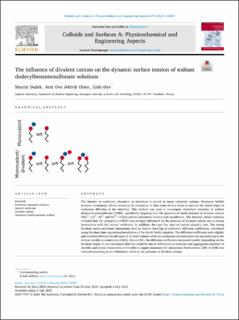| dc.contributor.author | Dudek, Marcin Jan | |
| dc.contributor.author | Jektvik Olsen, Arnt Ove | |
| dc.contributor.author | Øye, Gisle | |
| dc.date.accessioned | 2023-09-08T06:42:19Z | |
| dc.date.available | 2023-09-08T06:42:19Z | |
| dc.date.created | 2023-08-11T09:58:56Z | |
| dc.date.issued | 2023 | |
| dc.identifier.citation | Colloids and Surfaces A: Physicochemical and Engineering Aspects. 2023, 675 . | en_US |
| dc.identifier.issn | 0927-7757 | |
| dc.identifier.uri | https://hdl.handle.net/11250/3088069 | |
| dc.description.abstract | The kinetics of surfactant adsorption at interfaces is crucial in many industrial settings. Maximum bubble pressure tensiometry allows accessing the adsorption at time scales of tens of ms to uncover the initial stages of surfactant diffusion to the interface. This method was used to investigate electrolyte solutions of sodium dodecylbenzenesulfonate (SDBS), specifically targeting how the presence of small amounts of divalent cations (Mg2+, Ca2+, Sr2+ and Ba2+) influenced the adsorption kinetics and equilibrium. The dynamic surface tensions revealed that the adsorption of SDBS was strongly influenced by the presence of divalent cations due to strong interactions with the anionic surfactant. In addition, the type (i.e. size) of cations played a role. The strong divalent cation-surfactant interactions lead to distinct lowering of surfactant diffusion coefficients, calculated using the short-time approximation solution of the Ward-Tordai equation. The diffusion coefficients were slightly and similarly lowered for all types of divalent cations when the surfactant concentration was increased up to the critical micelle concentration (CMC). Above CMC, the diffusion coefficients increased steadily depending on the divalent cation. It was speculated that this could be due to differences in structure and aggregation numbers of micelles and slower disassembly of micelles to supply monomers for adsorption. Furthermore, CMC of SDBS was reduced according to the Hofmeister series in the presence of divalent cations. | |
| dc.description.abstract | The influence of divalent cations on the dynamic surface tension of sodium dodecylbenzenesulfonate solutions | |
| dc.language.iso | eng | en_US |
| dc.publisher | Elsevier | en_US |
| dc.relation.uri | https://www.sciencedirect.com/science/article/pii/S0927775723010919 | |
| dc.rights | Navngivelse 4.0 Internasjonal | * |
| dc.rights.uri | http://creativecommons.org/licenses/by/4.0/deed.no | * |
| dc.title | The influence of divalent cations on the dynamic surface tension of sodium dodecylbenzenesulfonate solutions | en_US |
| dc.title.alternative | The influence of divalent cations on the dynamic surface tension of sodium dodecylbenzenesulfonate solutions | en_US |
| dc.type | Peer reviewed | en_US |
| dc.type | Journal article | en_US |
| dc.description.version | publishedVersion | |
| dc.description.version | acceptedVersion | |
| dc.description.version | acceptedVersion | |
| dc.source.pagenumber | 8 | en_US |
| dc.source.volume | 675 | en_US |
| dc.source.journal | Colloids and Surfaces A: Physicochemical and Engineering Aspects | en_US |
| dc.identifier.doi | https://doi.org/10.1016/j.colsurfa.2023.132007 | |
| dc.identifier.cristin | 2166316 | |
| cristin.ispublished | true | |
| cristin.fulltext | original | |
| cristin.fulltext | postprint | |
| cristin.fulltext | postprint | |
| cristin.qualitycode | 1 | |

